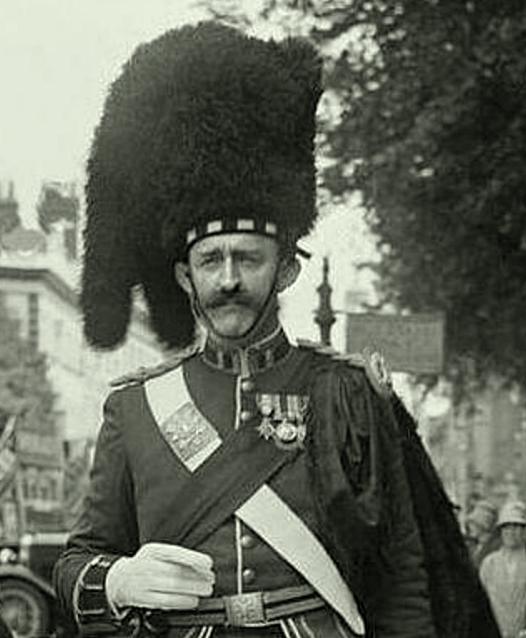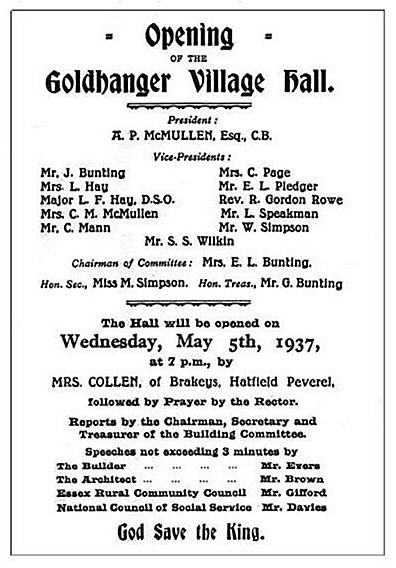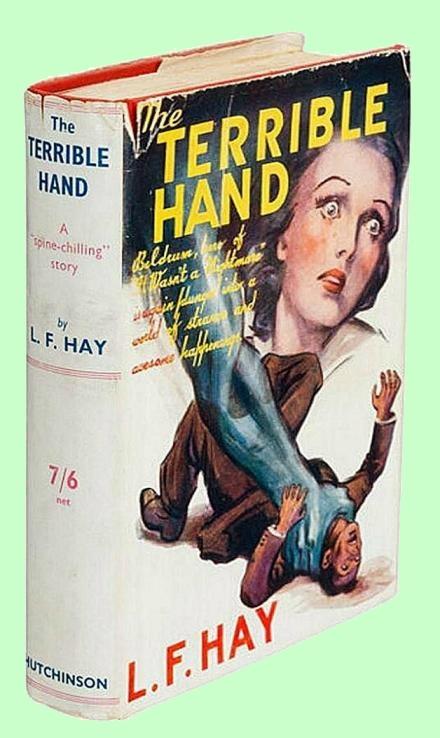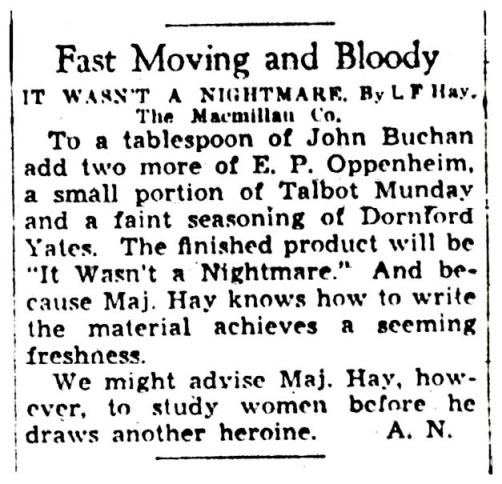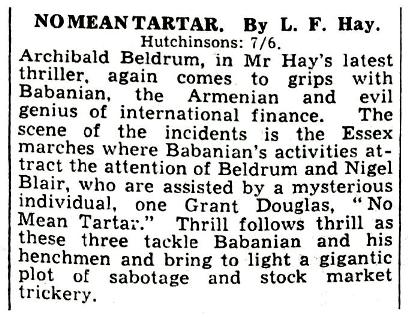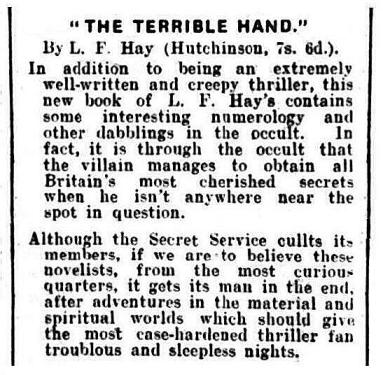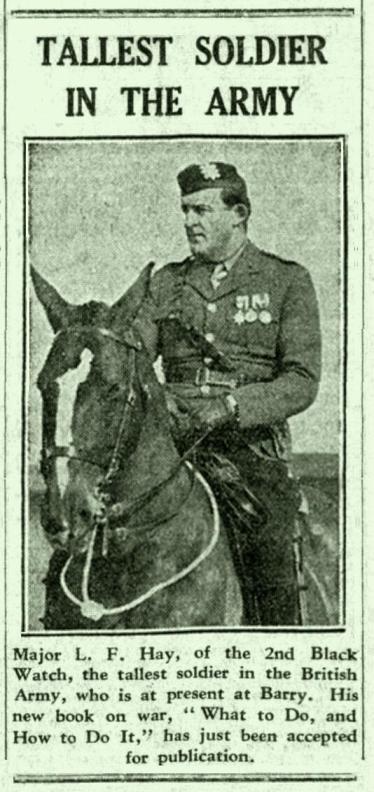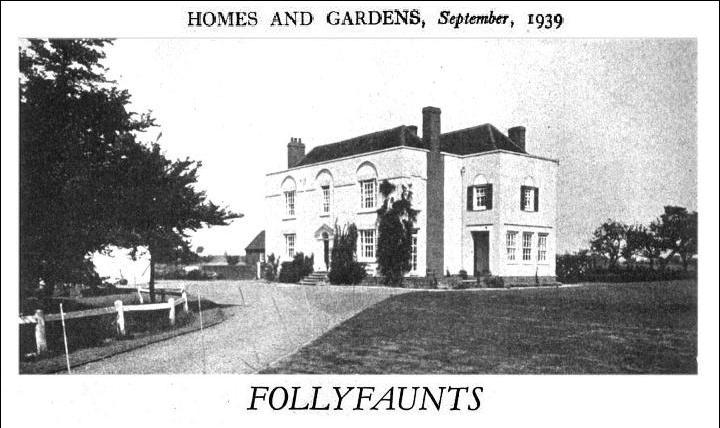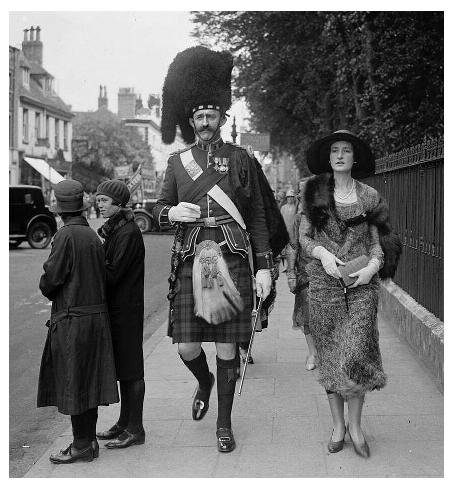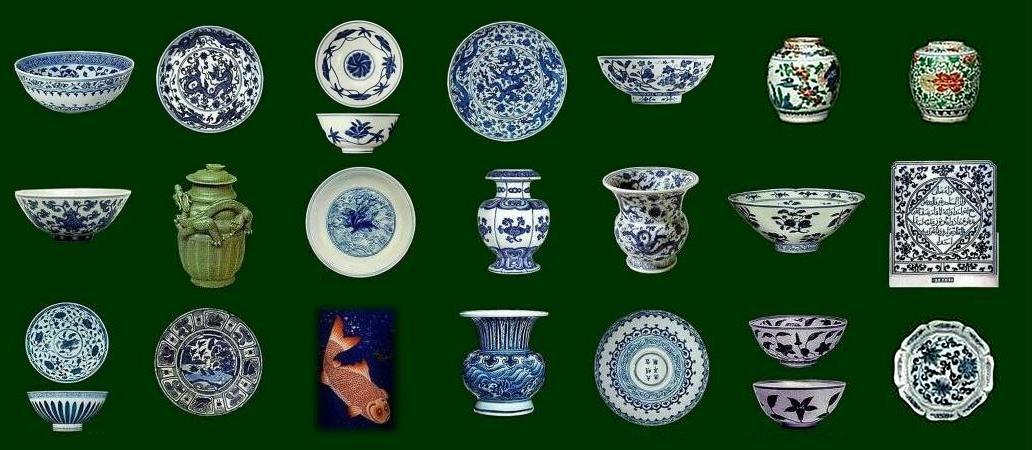|
Major Lindsay Fitzgerald Hay |
||||||||
|
1891 - 1946 |
||||||||
|
contents |
||||||||
|
o Summary |
||||||||
|
______________ Summary Major
Lindsay Fitzgerald Hay lived at Follyfaunts in Goldhanger
in the 1930s although
little was known about him locally at the time, much has been learnt about
him in recent times… o He was a serving
officer in the Great War, was wounded twice and decorated. o He took part in
the abortive offensive of Aubers Ridge in 1915. o At 6ft 11inches
was he the tallest man in the army at the time and nicknamed “The Lampost”. o Between the wars
he had travelled extensively in the middle east as an intelligence officer. o There are various
military references to him as “Lt Lord
Hay and Capt Lord Hay”, however, it has not been confirmed that
he had an hereditary title. o He wrote and
published four books while living at Follyfaunts in Goldhanger. o “Major L Hay,
DSO” is listed as a member of the first Village
Hall committee in 1937. o He was remembered
locally for his expensive cars. o In retirement he
became a very well known collector of high quality early Ming porcelain. o This reputation
lives on in the form of the “provenance” of what are now very valuable item
of Ming. o He moved back to
his family home at Nether Stowey in Somerset, where he died in 1946. |
||||||||
|
______________ Initial sources of information From.... “Follyfaunts House - A History” a booklet written in the 1980s for the then
owners by historian Peter Bushell... “Kelly's
Directory of the County of Essex for 1937 places Follyfaunts' in the
occupation of Lindsay Fitzgerald Hay, a major in the army. There are no very adequate
records for the period of the Second World War. They were either never
produced or were speedily pulped to help alleviate the chronic post-war paper
shortage”. The late Cyril Southgate recalled a “military gentleman” from
Follyfaunts bringing his expensive car into the village in the 1930s to fill
up with petrol at George Stoke’s filling station. Other locals remember the
very tall major who lived at Follyfaunts in the mid 1930s with an open topped
Bentley that was frequently parked in The Square and Church St. Major L Hay, DSO & Mrs L Hay are
listed as village hall committee members on a poster announcing the opening
of the Village Hall in 1937. |
||||||||
|
______________ Major Hay’s books From.... www.amazon.co.uk Books
written by Lindsay Fitzgerald Hay: 1.
Rifle Company and Platoon Tactics. -1935 What to do,
and how to do it 2. It
wasn't a nightmare -1937 3. The
Terrible Hand -1937 4. No
Mean Tartar -1938 |
||||||||
|
|
||||||||
|
It Wasn't a Nightmare from… Time USA March. 22. 1937 It Wasn’t
a Nightmare – L.F.Hay – Macmillan $2 A middle-aged English novelist and
his ward uncover the black doings of a Balkans munitions-maker; a first book by
a veteran British secret agent whose fictive boiling point is lower than
Oppenheim’s. [probably
referring to J. Robert Oppenheimer, director of the Manhattan Project in the
USA – ed.] From The
Catalogue of Copyright Entries…
|
||||||||
|
Copies of his three
novels are occasionally still available in antiquarian bookshops, and a copy
of “It wasn’t a nightmare” has been obtained. The 387 page hardback book,
published 1937, was printed in the
USA. No information about the author is given in the book and there is
nothing in the narrative to link Goldhanger to the book. The plot is very
Ian Fleming/James Bond like, (Fleming’s first Bond book wasn’t written until
1953). Written in the first person, the hero is an intelligence officer
recalled from a fishing trip in Scotland by his boss, the head of British
intelligence, to undertake an overseas assignment to track down a new
material remarkably like heavy water used in nuclear weapons. |
||||||||
|
from page-23… “Just as some
of these infernal, self-satisfied super-scientists are always trying to split
the atom**, indifferent whether in the process they shall detonate us into
dust, so some wretched chemist, grubbing about in a War Department laboratory
on Salisbury Plain, had invented a liquid which, though portable in glass
tubes, would bum through steel as effectively as a wineglassful of vitriol
will destroy a human face. …Starling was murdered in his laboratory three
days ago! But his invention hasn’t been suppressed, very much the reverse. It
appeared that the murderers had got away with Starling’s pet copy of his
formula for making the stuff. He had been fool enough to carry one in his
pocket.” The hero takes his
friend in a large Cadillac to the Pyrenees, and then they take the car on the
Luxuriatic cruise ship to The Balkans. Expensive hotels, cocktails,
troubles with the local police, car chases around the Balkan states, secret
rooms and trap doors, and shoot-outs with automatic weapons are involved
before their mission is successfully completed in Istanbul. The hero is
thanked by the Governor on Istanbul and the American ambassador. The words quoted
above seem incredible, considering they were written in 1937 by a serving (or
perhaps just retired) British intelligence officer, just 5-years after
Cockcroft and Walton announced splitting the atom in 1932. It was not until
5-years after the book was published, in 1942, that Oppenheimer was appointed
the director of the Manhattan Project, to create the world’s atomic bomb and
8-years before the atomic bomb was actually detonated in 1945. This was all the
more incredible as this was also the era of spying by Messrs Burgess Blunt,
MacClean, Philby & Blake: † Anthony Blunt was recruited as a Soviet
agent In the early 1930s † Guy Burgess became a spy in 1934 † Donald Maclean he was recruited as a Soviet
agent in 1938 † Kim Philby became a spy after joining MI6 in
1940 † George Blake switched sides in 1950 |
||||||||
|
The novel was
serialised in an Australian newspaper in 1937 |
and
reviewed...
|
|||||||
|
The
complete 192-page book is now available to read online from here... |
||||||||
|
______________ No Mean Tartar
|
||||||||
|
from
the Linwood Library Gazett (AU) in
1938...
|
||||||||
|
The Terrible Hand
very little else is
know about this book other than it seems
to contain the same characters as the other two |
Rifle Company and Platoon
Tactics “What to do, and
how to do it” by Major L F Hay of the Black Watch regiment Sifton Praed and Co, London, 1935 1 booklet, 52 pages, 6 x 4 inches 1s. 6d. the booklet is
referred to on several websites, but no images have
been seen _______________ |
|
||||||
|
A report in
The Evening Sun, Hanover, Pennsylvania, October 14, 1935 LONDON
LETTER Tallest man in the Army publishes small
book Major
L. F. Hay of the Black Watch, is generally acknowledged to be at 6ft. 10in.
the tallest man in the British Army. Though comparatively thin, he weights 19
stone. He is also very modest. He drives a small sports car, and in spite of
being an expert all-in wrestler I can vouch for him being one of the mildest
mannered motorists on the road. His book, which
has just been published is no less modest. Entitled "Rifle Company and Platoon Tactics”, it consists
of 52 pages, is 6x4 inches, and weighs three ounces. Some of the
abbreviations used are at first sight confusing. Tanks are called A.F.V.s,
which requires cross-word puzzle intelligence to realize is short for
Armoured Fighting Vehicles. ______________ |
||||||||
|
An article in Homes & Gardens magazine In
September 1939 a 3-page article appeared in Homes & Gardens about the
major and his home in Goldhanger. The article tells us that his fourth book
“No Mean Tartar” is semi-autobiographical and based partly on house
Follyfaunts and his cook at the time. The article also gives as a fascinating
insight into what Follyfaunts was like on the inside when the major lives
there, including scenes showing some of the Major’s Ming china. The article has
references to both his Ming china and his “thriller” No Mean Tartar, including that one the characters in the book is
based on his Cook Maria, these are marked with red lines on the copy here... |
||||||||
|
______________ |
||||||||
|
Military Service |
The lengthy biography
of Field Marshal Viscount Montgomery Monty, the making of a general
(1887-1942) written by Nigel Hamilton in 1981 is based on Montgomery’s
private papers, and reveals a complex relationship with military leaders and
has many ydetails about his personal life. “Capt L F hay" is named in
the caption to a large photograph in the book (adjacent to page 236) amongst
a extensive group of officers with Montgomery at
the Sandhurst staff college in 1927. Capt
Hay is seen standing at the end of a row of other officers who are all seated on a raised platform,
and he towers above the man standing in front of him. This demonstrates Hay’s
exceptional stature, although it would not be apparent from a cursory look at
the picture without knowledge of his height. |
|||||||
|
From an exchange
of information with members of… http://www.britishbadgeforum.com There is a
picture of him in “A Serious Disappointment”, a book about Aubers Ridge. He's
6' 11", may be LT Hay. It could be Capt
Lindsay Fitzgerald Hay of the Black Watch (Royal Highlanders), who was
commissioned into the Regiment on 26 Aug 14. He was wounded twice during the
war, was mentioned in despatches on 28 Nov 17 and was awarded
the 1914-15 Star. Captain Lindsay
Fitzgerald Hay Royal Highlanders.At 6ft 11 1/2 inches was he the tallest man
in the British army. On the left is a
postcard dated Aug 1918. On the right
is a photo entitled: Capt. L.F. Hay
and two Ghurkhas, India 1925
The
message on the reverse of the postcard on the right read: “This tall man is Captain
(Lord) Hay of The Black Watch. He is the tallest officer in the British Army and was for a time my
company commander”. The following list is from the
publication: Officers of The Black Watch 1725-1986 Hay, Lindsay Fitzgerald: Public
Schools Commission 2/Lt 26 Aug 1914, Lt
26 Sep 1914; Wounded
in France 22 Oct 1914, and Sept 1915; Capt
2 March 1916; GSO3
2 Aug 1917; Bde
Major 27 Nov 1917; GSO2
4 Aug 1919; Staff
Capt 2 March 1928; Major
26 Feb 1930; GSO2
25 Sep 1930; [GSO2=General Staff
Officer, 2nd grade] Retired
1935; Died
4 Feb 1946. He receives a brief mention in The Great War by Lionel Sotheby ISBN O 8214 1178 0: Feb
21 1915. Lt Lord Hay has just turned up. He was wounded and has now just come
back bringing a draft of 67 men. Hay is an immense fellow being just over 6
foot 11 inches. Indeed at first coming out of my dwelling I thought a lampost
had been suddenly erected till he turned round. A foot note reads: Lt
Lord Hay, wounded 22 Oct 1914 at Ypres and again at Loos 25 Sept 1915 was
reputed to be the tallest soldier in the British Army. [ no other
references to Major Hay being a “Lord”
have been found ] from the Regimental History Vol 1... L F Hay was present at the following battles: Aisne 1914,
Ypres 1914, Neuve Chapelle
1915, ______________ Photographs from Major Hay’s military
service
|
||||||||
|
______________ |
||||||||
|
As a collector of early Ming porcelain |
||||||||
|
In
The Calendar Of The School Of Oriental Studies, University of London –
1937: Major L. F. Hay is listed as a Governor |
||||||||
|
Extracts taken from a website entitled: CARP: Chinese Art - Research into
Provenance, Department of History of Art, University of Glasgow… Major Lindsay
Fitzgerald Hay
(1891-1946), of Bath, was a collector of early Ming porcelain, usually of the
highest quality. He came from a distinguished military family, his
grandfather being Admiral James Beckford L. Hay (1796-1842), and his father,
Captain Albert Washington Hay (1854-1942). He himself was commissioned into
the Royal Highlanders (Black Watch), in 1914, took part in the abortive
offensive of Aubers Ridge in 1915 and was Mentioned in Dispatches in 1917. He
was reputed to be the tallest man in the British Army during his period of
service (6'11"). Sales of his collection were held at Sotheby’s in June
1939, and June 1946, the latter by order of the executors. At the time of his
death on 7 February 1946, he was resident at Old House, Nether Stowey in
Somerset. Published
sources Sotheby & Co., 16 June 1939, ‘The
well-known collection of rare early Ming blue and white porcelain. The
property of Major L.F. Hay’. Sotheby & Co., 25 June 1946,
‘Catalogue of important Chinese ceramics, the property of late Major Lindsay
F. Hay, sold by order of the executors; and others’. Adrian Bristow, 'A Serious
Disappointment: The Battle of Aubers Ridge, 1915 and the Subsequent Munitions
Scandal', London, 1995. |
||||||||
|
Extracts from the
website… Bluett Essay, by Dominic
Jellinek [Bluett
& Sons were famous London Ming porcelain dealers] One of the more unusual - it is
tempting to say eccentric - of the earlier collectors was Major Lindsay F. Hay. The picture that may be
built up from the Bluett Day Books and, to a lesser extent from those of
Messrs. John Sparks, can only be a partial one and merely hints at a more
interesting story. Hay was well known to the older members of the London
Chinese trade as the man who built up a fine collection fairly quickly, sold
it at auction and then a few years later built up a second, very similar one,
buying back a number of his old pieces in the process. Hay made his first purchase from
Bluetts in March 1938, three Ming dynasty blue and white bowls and on the
same day made his first purchase from Sparks, a Xuande blue and white dragon
jar and cover, lot 37 from the Wu Lai-tse sale, for £32. He made a few
further purchases from both firms, acquired other Wu Lai-tse pieces from
Yamanaka and H.R.N. Norton, then put his collection up for sale, in June
1939, at Sotheby's. Billed as The Well Known Collection of Rare Early Ming
Blue and White Porcelain. The Property of
Major Lindsay F. Hay, of Bath, it comprised
48 items, mostly 15th century, including three Chenghua
"Palace bowls". The group sold for a total of £1,275. Major Hay appears again in Bluetts Day
Books in October 1943 and over a period of almost exactly two years purchased 36 pieces, mainly 15th century with a
few 16th century, all blue and white, including a group of eight pieces that
had been sold in his 1939 sale to the collector Lionel Edwards. (At the
Edwards estate sale in February 1945 he paid £625 for pieces that had raised
only £234 in his 1939 sale). He seems to have made no purchases from Sparks
at this time and must have died towards the end of 1945. In June 1946 the
collection was sold, again at Sotheby's, similarly billed as The Well Known
Collection of Chinese Blue and White Porcelain of the 15th and 16th
Centuries. The Property of the Late Lindsay F. Hay. This group comprised 66 lots, again with three
Chenghua "Palace bowls", and made a total of £3,437:10 (see Plate
30 & Plate 31). As with the Paget
collection, Hay pieces still come up for sale from time to time, almost
always of the highest quality. In a sense collectors such as Paget
and, in his first manifestation, Lindsay Hay, with regard to the Imperial
ceramics they purchased, were "first generation" buyers in that
many of the pieces they bought were not long out of the Palace stores and had
not before been in private hands. |
||||||||
|
______________ Images of his Ming porcelain collection Of the many items
of Ming china referred to in the articles above, the ones shown below have
been offered for sale in the last 20-years with references to... “the provenance
Major Lindsay Fitzgerald Hay”. Select the image for an enlargement with short descriptions of
the items... |
||||||||
|
______________
Major
Lindsay Fitzgerald Hay 1891-1946 Major in the Black Watch
regiment Wounded twice and decorated in WW-1 Tallest man in the British
Army Lived at Follyfaunts
in the 1930s Wrote four books while at
Goldhanger Famed for his
collection of early Ming china ______________ return to… |
||||||||
